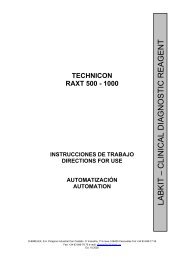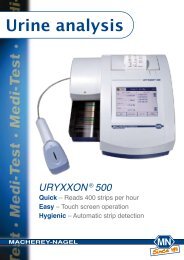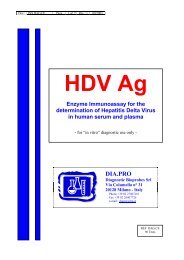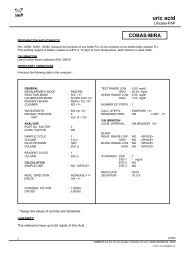Helena C-4 - Atest/Marketing
Helena C-4 - Atest/Marketing
Helena C-4 - Atest/Marketing
Create successful ePaper yourself
Turn your PDF publications into a flip-book with our unique Google optimized e-Paper software.
Operation Manual<br />
<strong>Helena</strong> C-4 - Software C11.11b<br />
<strong>Helena</strong> Biosciences Europe<br />
UK<br />
9.7. APTT-Based Factor Assays (VIII, IX, XI & XII)<br />
REAGENT PREPARATION<br />
Reconstitute Factor Deficient Plasma and<br />
prepare APTT reagents according to<br />
package insert.<br />
SYSTEM PREPARATION<br />
1. Turn on instrument and wait for green<br />
LED light to come on.<br />
2. Turn on printer if connected.<br />
3. Connect optional Autopipette to system.<br />
4. Check system setup if necessary<br />
5. Check test setup if necessary. Select<br />
method, enter new calibration curve data.<br />
6. Return to main menu and enter<br />
“Analysis” by pressing #1. Select<br />
appropriate factor assay with the Up /<br />
Down arrow keys or enter the numeric<br />
test code. If any warning or error<br />
message appears, refer to section 7.0.<br />
TEST PROCEDURE<br />
All quality control and patient samples<br />
are diluted 1:10 in Owren’s Veronal<br />
Buffer (OVB) for testing. If the<br />
clotting times fall outside of the linear<br />
curve, prepare and test 1:5 or 1:20<br />
dilutions as needed. It is<br />
recommended to test 2 dilutions (1:10<br />
& 1:20) for each sample. Refer to the<br />
reagent package insert for more<br />
information.<br />
Clotting Method<br />
1. Place CaCl 2 in large central reagent<br />
position.<br />
2. Pipette 25 µL of diluted plasma and<br />
25 µL of deficient plasma into each<br />
cuvette. Refer to chart for sample<br />
preparation.<br />
3. Incubate for 2 min, or the time<br />
indicated in reagent package insert.<br />
4. Add 25 µL of APTT reagent. Incubate<br />
for 3 or 5 minutes. Refer to package<br />
insert for appropriate<br />
activation/incubation times. Press the<br />
“TIMER 1” key to start stopwatch 1.<br />
5. Transfer cuvette to measuring position.<br />
6. While incubating, press “OPTIC 1”. If<br />
selected, enter PAT-ID with numeric<br />
keys or Up/Down keys. Confirm by<br />
pressing “OPTIC 1” again. The message<br />
“ACTIVE” is displayed and channel 1 is<br />
ready to start the reaction. Repeat for<br />
the remaining channels.<br />
7. Add 25 µL prewarmed CaCl 2 The<br />
test will start automatically on<br />
addition of the start reagent. If<br />
not simultaneously press the “OPTIC<br />
1” key. The test will automatically<br />
start if using the Autopipette.<br />
(CAUTION: When the test procedure is<br />
running, pressing the “OPTIC 1” and<br />
the “Enter” keys will interrupt the<br />
test). Repeat for remaining channels.<br />
8. The instrument will read for 300 secs.<br />
If no clot is detected, the display will<br />
read “+++” and “No Clot Detected”<br />
will print.<br />
9. The result is displayed in seconds.<br />
Press the corresponding “Unit” key for<br />
conversion of results if a printer is not<br />
attached.<br />
10. For patient and control samples diluted<br />
1:10, this is the final result. If other<br />
dilutions are tested, the calculated<br />
value should be multiplied by the<br />
appropriate dilution correction factor.<br />
(i.e., samples diluted 1:20, multiply<br />
result by 2; for 1:40 dilutions, multiply<br />
by 4, etc.)<br />
ASSAY CALIBRATION<br />
For calibration curves, a minimum of two<br />
values is required, with a maximum of 5.<br />
It is highly recommended that more<br />
than two calibration points be used.<br />
1. Make dilutions of Calibrator (SARP Cat<br />
No: 5185) in OVB A suggested<br />
standard curve is shown below.<br />
2. Assay standards in quadruplicate as<br />
described.<br />
3. Enter calibration data (% activity and<br />
seconds) in “Setup Test”. Check<br />
calibration curve with QC controls<br />
SAC-1; 5301 and SAC-2; 5302.<br />
Sample Dilution Preparation<br />
100%<br />
Standard<br />
1:10 100 uL reference<br />
plasma + 900 uL OVB<br />
50%<br />
Standard<br />
1:20 50 uL of reference<br />
plasma + 950 uLOVB<br />
25%<br />
Standard<br />
1:40 25 uL of reference<br />
plasma + 975 uL OVB<br />
12.5%<br />
Standard<br />
Patient or<br />
Control<br />
1:80 500 uL of 25%<br />
standard + 500 uL<br />
OVB<br />
1:10 100 uL sample + 900<br />
uL OVB<br />
47


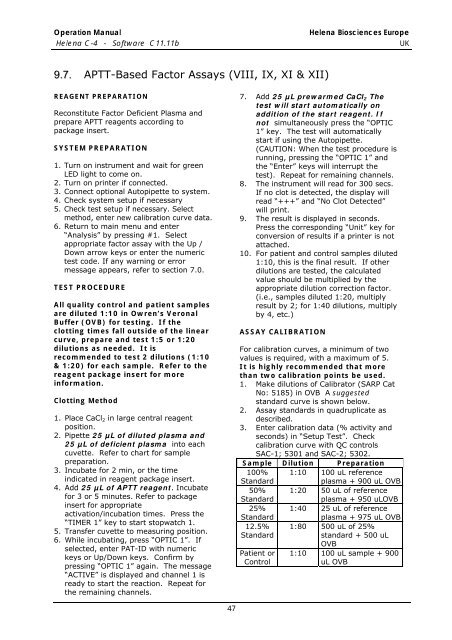
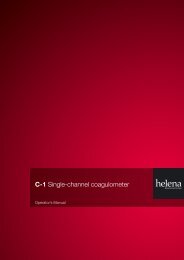
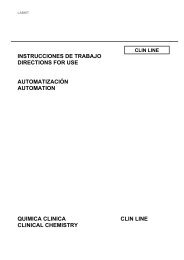
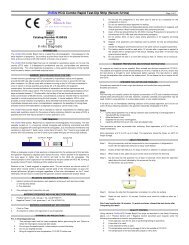
![[APTT-SiL Plus]. - Agentúra Harmony vos](https://img.yumpu.com/50471461/1/184x260/aptt-sil-plus-agentara-harmony-vos.jpg?quality=85)


![[SAS-1 urine analysis]. - Agentúra Harmony vos](https://img.yumpu.com/47529787/1/185x260/sas-1-urine-analysis-agentara-harmony-vos.jpg?quality=85)


![[SAS-MX Acid Hb]. - Agentúra Harmony vos](https://img.yumpu.com/46129828/1/185x260/sas-mx-acid-hb-agentara-harmony-vos.jpg?quality=85)

